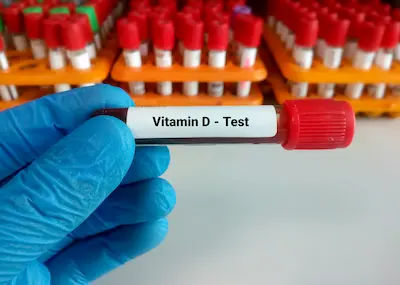The Ultimate Guide to Vitamin D Testing; Why, When, and How
Learn everything about vitamin D testing in this ultimate guide—why it matters, when to get tested, how the test works, what results mean, and how to optimize your levels for stronger bones, better immunity, and overall health.

.webp?tr=q-80,f-webp,w-350,dpr-2,c-at_max 700w)
Feeling constantly tired, battling frequent bugs, or just generally run down? You might be among the nearly 42% of the US population with a vitamin D deficiency. Often called the "sunshine vitamin," D is a crucial hormone that impacts everything from your bone strength to your immune system. But how do you know if you're getting enough? This is where a vitamin D test becomes your most valuable tool. This comprehensive guide will illuminate everything you need to know: from recognizing the subtle signs of deficiency and understanding who's most at risk, to demystifying your test results and crafting a personalized plan to optimize your levels for vibrant health. Let's shed some light on the process.
What is Vitamin D and Why Is It So Important?
Vitamin D is unique because it functions as both a vitamin we consume and a hormone our bodies make. Its most famous role is as the director of calcium absorption, ensuring we have strong, healthy bones and preventing conditions like rickets in children and osteoporosis in adults. However, modern research has revealed that its job description is far more extensive. Vitamin D receptors are found throughout the body, including on immune cells, meaning it plays a pivotal role in modulating our immune response, potentially reducing the risk of infections and autoimmune diseases. It's also involved in muscle function, mood regulation, and cell growth.
A key concept to understand is the difference between the two main forms. Vitamin D2 (ergocalciferol) comes from plant sources like mushrooms and is often used in fortified foods and prescriptions. Vitamin D3 (cholecalciferol) is the form synthesized in our skin upon exposure to sunlight and is found in animal-based foods like fatty fish and egg yolks. Most experts agree that D3 is more effective at raising and maintaining overall vitamin D levels in the blood, making it the preferred form for supplementation.
Why Should You Consider a Vitamin D Test?
You can't manage what you don't measure. While symptoms can be a clue, they are often vague and overlap with many other conditions. The only way to know your vitamin D status for sure is through a blood test. Certain groups are at a significantly higher risk for deficiency. This includes people with darker skin (as melanin reduces the skin's ability to produce vitamin D), those who are older, individuals living in northern latitudes with limited sun exposure, people with conditions that affect fat absorption (like Crohn's disease or celiac disease), and those who are obese (as vitamin D can get sequestered in body fat).
The signs of low vitamin D can be subtle but impactful. Beyond the well-known link to bone pain and muscle weakness, deficiency has been associated with:
- Persistent fatigue and tiredness
- Low mood or feelings of depression
- Frequent illnesses or infections
- Impaired wound healing
- Hair loss
If you identify with several of these symptoms or fall into a high-risk category, discussing a vitamin D test with your doctor is a logical next step.
Demystifying the Vitamin D Test Itself
The standard and most accurate test for assessing vitamin D status is the 25-Hydroxy Vitamin D Test, also known as calcifediol. This test measures the major circulating form of vitamin D in your bloodstream, which is a good reflection of your overall stores from both sun exposure and dietary intake.
Consult a Specialist for Personalised Advice
The process is straightforward and identical to a standard blood draw. A phlebotomist will typically draw blood from a vein in your arm. The test requires no special preparation like fasting, making it a convenient procedure. You can get it done at your doctor's office, a hospital, or an independent laboratory. In recent years, at-home vitamin D test kits have also become popular. These allow you to collect a small blood sample via a finger prick and mail it to a lab for analysis. While convenient, it's important to choose a kit from a reputable, CLIA-certified company to ensure accuracy and to discuss the results with a healthcare professional.
Interpreting Your Vitamin D Test Results: A Deep Dive
Your test report will show your level in nanograms per milliliter (ng/mL) or nanomoles per liter (nmol/L). General interpretations are as follows:
- Deficiency: < 12 ng/mL (< 30 nmol/L)
- Insufficiency: 12-20 ng/mL (30-50 nmol/L)
- Sufficiency: 20-50 ng/mL (50-125 nmol/L)
- Potential Toxicity: > 50 ng/mL (> 125 nmol/L)
However, here lies the controversy. While most labs and institutions agree that below 12 ng/mL is deficient, the definition of "optimal" is debated. Some functional medicine practitioners argue that levels of 40-60 ng/mL are ideal for maximizing health benefits, particularly for immune function. It's crucial to interpret your results in the context of your overall health and under the guidance of your doctor. Extremely high levels, often caused by excessive supplementation, can lead to toxicity (hypervitaminosis D), causing nausea, vomiting, and dangerous calcium buildup.
What to Do After Your Vitamin D Test
Your result is a starting point, not an endpoint. If your levels are low, your doctor will help you formulate a plan. The three pillars of raising vitamin D are:
1. Sunlight: Aim for sensible, brief sun exposure (e.g., 10-15 minutes, arms and legs exposed, several times a week).
2. Diet: Incorporate more fatty fish (salmon, mackerel), fortified milk and cereals, egg yolks, and UV-exposed mushrooms.
3. Supplements: Vitamin D3 supplements are often necessary to correct a deficiency. Your doctor will recommend a specific dosage based on your severity.
Retesting is critical. After starting a supplement regimen, your doctor will typically recommend a follow-up vitamin D blood test in 3-4 months to check your progress and adjust the dosage accordingly, ensuring you reach and maintain your target level without overshooting.
Conclusion
Understanding your vitamin D status through a simple test is a powerful step toward taking control of your health. It moves you from guessing about fatigue and low immunity to having a clear, actionable data point. Whether your levels are optimal, insufficient, or deficient, you now have the knowledge to work with your healthcare provider to develop a plan. Remember, the goal is balanced, sustainable health—not just a number on a lab report. Embrace sensible sun exposure, nourish your body with vitamin D-rich foods, and use supplementation wisely under medical advice. Ready to stop guessing? Talk to your doctor today about whether a vitamin D test is right for you.
Consult a Specialist for Personalised Advice
Consult a Specialist for Personalised Advice

Dr. Praveen Kumar Mukka
General Physician/ Internal Medicine Specialist
21 Years • MBBS, MD General Medicine
Hyderabad
Apollo 24|7 Clinic - Telangana, Hyderabad
(75+ Patients)

Dr Summaiya Banu
General Practitioner
8 Years • MBBS
Hyderabad
Apollo 24|7 Clinic, Hyderabad
(225+ Patients)

Dr. Shubham Chauhan
General Practitioner
4 Years • MBBS
Lucknow
Apollo 24|7 Clinic - Uttar Pradesh, Lucknow

Dr. Mainak Baksi
General Practitioner
13 Years • MBBS , MD (MPH)
Howrah
Mainak Baksi Clinic, Howrah
(50+ Patients)

Dr. Rajib Ghose
General Physician/ Internal Medicine Specialist
25 Years • MBBS
East Midnapore
VIVEKANANDA SEBA SADAN, East Midnapore
Consult a Specialist for Personalised Advice

Dr. Praveen Kumar Mukka
General Physician/ Internal Medicine Specialist
21 Years • MBBS, MD General Medicine
Hyderabad
Apollo 24|7 Clinic - Telangana, Hyderabad
(75+ Patients)

Dr Summaiya Banu
General Practitioner
8 Years • MBBS
Hyderabad
Apollo 24|7 Clinic, Hyderabad
(225+ Patients)

Dr. Shubham Chauhan
General Practitioner
4 Years • MBBS
Lucknow
Apollo 24|7 Clinic - Uttar Pradesh, Lucknow

Dr. Mainak Baksi
General Practitioner
13 Years • MBBS , MD (MPH)
Howrah
Mainak Baksi Clinic, Howrah
(50+ Patients)

Dr. Rajib Ghose
General Physician/ Internal Medicine Specialist
25 Years • MBBS
East Midnapore
VIVEKANANDA SEBA SADAN, East Midnapore
Frequently Asked Questions
How much does a vitamin D test cost?
The cost of a vitamin D test can vary widely based on your insurance, location, and the lab used. Without insurance, it can range from $50 to $200. Many insurance plans cover it if it's deemed medically necessary by your doctor. At-home test kits typically cost between $70 and $120.
Can I test my vitamin D levels at home?
Yes, several reputable companies offer at-home vitamin D test kits. These involve a finger-prick blood sample that you mail to a lab. They are convenient, but it's essential to share the results with your doctor for a clinical interpretation and recommendations.
What is a normal vitamin D level for a woman?
There is no different 'normal' range based on gender. The general sufficiency range of 20-50 ng/mL applies to both men and women. However, women, especially postmenopausal women, are at a higher risk for osteoporosis, making maintaining adequate levels particularly important for long-term bone health.
How often should you get a vitamin D test?
If you are deficient and undergoing treatment, your doctor will likely retest in 3-4 months. Once your levels are stable, retesting every 1-2 years may be sufficient for monitoring, unless your health status changes. Your doctor can provide a personalized schedule.
What is the best time to take a vitamin D supplement?
Since vitamin D is fat-soluble, taking it with a meal containing healthy fats can enhance absorption. Many people find taking it with their largest meal (e.g., breakfast or dinner) is an easy way to remember. There is no significant evidence that taking it at night disrupts sleep.

.webp)